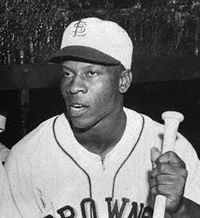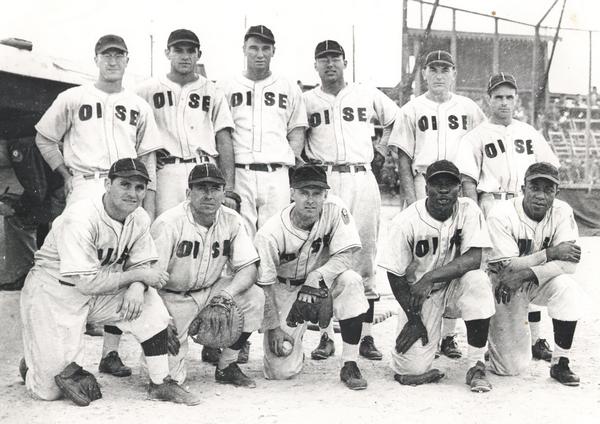

Would you like to sponsor this page? Contact gary@baseballinwartime.com
 Willard Brown
Willard Brown
Date and Place of Birth: June 26, 1915 Shreveport, Louisiana
Died: August 4, 1996 Houston, Texas
Baseball
Experience:
Major League
Position: Outfield
Rank: Unknown
Military Unit: US Army
Area Served: European Theater of Operations
Major League Stats: Willard Brown on Baseball-Almanac
 Willard J.
Brown was born on June 26, 1915 in Shreveport, Louisiana. Joining
the Kansas City Monarchs of the Negro American League in 1934, he
played his entire Negro League career with that team.
Willard J.
Brown was born on June 26, 1915 in Shreveport, Louisiana. Joining
the Kansas City Monarchs of the Negro American League in 1934, he
played his entire Negro League career with that team.
Brown began his professional career as a shortstop but moved to the outfield in 1938, the same year he led the Negro American League with six home runs.
A power hitter who swung a 40-ounce bat, Brown led the league in home runs again in 1942 and 1943. The following year he was in military service with the Army and served in Europe.
While in France, Brown was recruited by former Phillies’ pitcher, Sam Nahem, to play for the OISE All-Stars, who represented Com-Z (Communications Zone) in the 1945 ETO World Series.
The OISE All-Stars were definite underdogs going into the best-of-five series. Their formidable opponents – the 71st Division Red Circlers, who represented the Third Army, had a lineup featuring outfielders Harry Walker and Johnny Wyrostek, infielders Benny Zientara and Bob Ramazzotti and a mound staff that included Ewell Blackwell, Al Brazle and Ken Heintzelman.
The All-Stars lineup was dotted with semi-pro players. Only Nahem had any worthy major league experience but the lineup was bolstered by the addition of two outstanding African- Americans – Willard Brown and pitcher Leon Day.
The first game of the series was played at Soldier Field in Nurnberg, Germany, on August 30, 1945. The Red Circlers took the game, 9-2, with Ewell Blackwell allowing just five hits. Brown was "the only man who had much luck hitting Blackwell," wrote The Stars and Stripes on September 3, 1945.
 |
| OISE All-Stars ETO World Series Champions in 1945. Willard Brown is front row, fourth from left. |
Game two, also at Nurnberg, was a pitching duel with Negro League superstar, Leon Day, claiming a 2-1 victory for the All-Stars. Brown's sixth inning single scoring Joe Herman with the go-ahead run. The third game of the series moved to the All-Stars home ground in Rheims, France, and was another 2-1 win for the All-Stars with Brown scoring the first run on a double by Nick Macone. The Red Circlers came back to tie the series in game four, winning 5-0 against Leon Day with a two-run home run from Harry Walker. The fifth and deciding game was played at Nurnberg on September 8, with the OISE All-Stars edging the Red Circlers 2-1, to claim the ETO World Series crown. Both Brown and Day, Negro League stars playing as part of an integrated team, were key factors in the OISE victory.
Brown returned to the Kansas City Monarchs in 1946, batting .348 for second best in the league and leading the circuit with 13 home runs. With Jackie Robinson breaking the Organized baseball color-line in 1946, Willard Brown was signed by major league baseball’s St. Louis Browns in July 1947, in the hopes that he might help the ailing team and made his debut on July 19 against the Boston Red Sox. However, he was 31 years old by then. In his only major league season – which lasted just one month - Brown batted .179 in 21 games but did hit the first home run by an African-American in the American League.
Willard Brown let his bat speak for him in the winter following his release from St. Louis. In the Puerto Rican Winter League, Brown hit 27 home runs while winning the league's Triple Crown.
He rejoined the Kansas City Monarchs in 1948, and won the Negro American League batting title in 1951 with a .417 average. In 1954, aged 43, he was back in organized baseball, and hit 35 home runs in the Texas League to help lead Houston to the pennant.
Willard Brown passed away on August 4, 1996 in Houston, Texas. He was 81 and had been suffering from Alzheimer’s.
Brown was elected to the Baseball Hall of Fame by Special Committee in 2006.
Created May 29, 2007. Updated May 6, 2010.
Copyright © 2015 Gary Bedingfield (Baseball
in Wartime). All Rights Reserved.